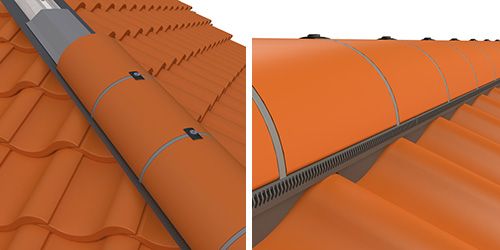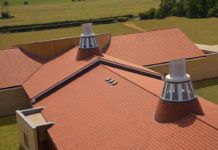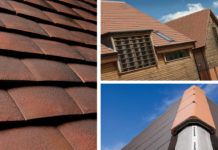
From discussions in the latest innovations and standards in the roofing world, to insight into the Wienerberger roof team, John’s knowledge from his 40-year-long career has continued to bring exciting columns each month. Wienerberger expertise and knowledge will continue in upcoming ‘The Pitch’s’, but for now, here is one final treat from John.
Using Dry fix systems and accessories
As I write this I have lost track of the number of articles and social media posts published about the new Dry Fix Standard; BS 8612 – my own included, since its publication on January 31 this year. The great thing is the roofing industry is now extremely good at promoting new or revised standards, as was the case with the latest revision to BS 5534 when that was published. This all leads to a greater awareness in the industry because otherwise many people would simply not be aware of the existence of new standards and legislation.
I am therefore confident that the industry is becoming far more conscious of the importance of specifying and using dry fix products of good quality and which comply with the recommendations given in BS 8612.
The purpose of this article is to highlight the importance of how trades must work closer together to ensure all roofing components, whether they be the roof tiles or the systems and accessories, can be correctly and securely installed. Without good communication and cooperation, problems between the various trades can occur during the construction of a building, some of which I highlight in this article.
Plastic fascias
At roof perimeters, all single lap tiles must be twice fixed. This means that, at the eaves, tiles should be nailed at the head and clipped at the tail. The widespread use of plastic fascias has created a problem for roof tiling in that some plastic fascias do not provide an adequate fixing for a clip nail. This is a point to be considered by both the roofer and builder prior to commencement of works. In many cases, the solution can be to install a timber directly behind the fascia to provide a suitable fixing for the clip nails.
Another common problem can be the incorrect alignment of the fascia height. This should be set so that the eaves course tiles sit at the same angle (pitch) as the tiles in the courses above. Tile manufacturers generally provide fascia height tables; though remember that it is the fascia installer who needs these, rather than the roofer. If installing a continuous over fascia ventilation system, remember to adjust the fascia height accordingly.
Dry verge systems
Manufacturers of dry verge systems provide the means to secure the system components to the tile battens, bargeboard or directly to the gable wall. At the eaves, it is common to fit either a special eaves dry verge unit, or an extra ‘eaves closure’ unit. Whatever the design, the purpose is to provide not only a secure fixing, but to also close any gap between the dry verge unit and wall, preventing the ingress of birds and rodents into the roof space and batten cavity. This all works well provided there is a sound substrate to fix to; e.g. a timber bargeboard or masonry wall. Unfortunately, all too often, this is not the case and the roofer struggles to achieve a secure fix of the eaves dry verge units. The risk is, if the verge units are not securely installed, they will be dislodged by winds. Worse than that, once the eaves verge unit is dislodged, the verge units in the course above will also be dislodged.
My message, therefore, is to emphasise the importance of a correct and adequate structure being in place for fixing the dry verge to; it may be a matter of ensuring the masonry is finished at the correct level or, alternatively, fitting some suitable timberwork behind and to the side of the eaves fascia.
Another issue relating to dry verge systems is the suitability of the gable wall surface. In general, dry verge systems are best suited to fit against smooth walls such as brickwork, render or bargeboards. It is possible to install a dry verge against, for example, a pitched-faced stone wall by setting the verge units off the wall to align with the outermost points of the walling. In this case, provision is required to close any resulting gaps between the wall and dry verge, normally achieved by installing plywood or fibre cement boards on the wall top, under the tile battens and extending out to close the gap.

Wall abutments
A common problem can be misalignment between cavity trays and roof tile abutment flashings. Cavity trays are installed to collect and shed water entering a cavity wall at the point where an external wall skin becomes an internal wall, to prevent dampness reaching the inner wall. The vertical upstand of the tile flashing should dress into the wall in the same masonry joint as the cavity tray to prevent any water from entering between the two systems, therefore careful coordination between bricklayer and roofer is important to ensure that this happens.
Access for installation
The requirement to mechanically fix all tiles means that roofers are no longer able to push unfixed tiles up so they can walk on the battens. Roof tiles and slates are not designed to be walked on without adequate protection; it is not particularly safe either.
I am therefore suggesting that architects perhaps ought to consider the limitations in working practices of roofing contractors when they are designing the roof shape. For example, it is difficult, if not impossible, to install a hip system without standing on laid roof tiles. I am not suggesting hips be designed out of the roof (although there is something to be said for that), but perhaps some form of access could be designed into the roof, such as steps. This is common practice in Europe.
In summary:
- Ensure fascias are set at the correct height and, in the case of plastic fascias, provision is provided to fix the tails of the eave course tiles
- Provide adequate provision for securing eave course dry verge units, whether they be individual (i.e. one unit per tile course) or continuous verge systems
- If using dry verge against pitched-faced walling, make provision to close any resulting gaps if the verge units are set away from the wall
- Take care to coordinate the installation of cavity trays with the tile flashings at abutments
- Consider roof access and the working practices of roofers in the roof design
For more The Pitch articles from John Mercer click here.




